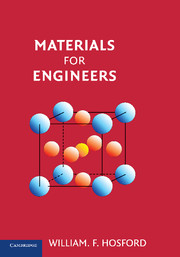Book contents
- Frontmatter
- Contents
- Preface
- 1 Introduction
- 2 Phases
- 3 Diffusion
- 4 Mechanical Behavior
- 5 Mechanical Failure
- 6 Annealing
- 7 Iron and Steel
- 8 Nonferrous Metals
- 9 Casting and Welding
- 10 Solid Shaping
- 11 Polymers
- 12 Polymer Processing
- 13 Glasses
- 14 Crystalline Ceramics
- 15 Powder Processing
- 16 Pottery and Concrete
- 17 Composites
- 18 Carbon
- 19 Fibers, Foams, and Porous Materials
- 20 Electrical Properties
- 21 Optical and Thermal Properties
- 22 Magnetic Materials
- 23 Corrosion
- 24 Modern Manufacturing Techniques, Surface Treatments, and Recycling
- APPENDIX 1 Wood
- APPENDIX 2 Miller Indices for Planes and Directions
- APPENDIX 3 X-ray Diffraction
- APPENDIX 4 Surfaces
- APPENDIX 5 Dislocations
- APPENDIX 6 Avrami Kinetics
- APPENDIX 7 Organic Chemistry
- APPENDIX 8 Average Molecular Weight
- APPENDIX 9 Bond Geometry in Compounds
- APPENDIX 10 Weibull Analysis
- Index
- Conversions
6 - Annealing
Published online by Cambridge University Press: 05 June 2012
- Frontmatter
- Contents
- Preface
- 1 Introduction
- 2 Phases
- 3 Diffusion
- 4 Mechanical Behavior
- 5 Mechanical Failure
- 6 Annealing
- 7 Iron and Steel
- 8 Nonferrous Metals
- 9 Casting and Welding
- 10 Solid Shaping
- 11 Polymers
- 12 Polymer Processing
- 13 Glasses
- 14 Crystalline Ceramics
- 15 Powder Processing
- 16 Pottery and Concrete
- 17 Composites
- 18 Carbon
- 19 Fibers, Foams, and Porous Materials
- 20 Electrical Properties
- 21 Optical and Thermal Properties
- 22 Magnetic Materials
- 23 Corrosion
- 24 Modern Manufacturing Techniques, Surface Treatments, and Recycling
- APPENDIX 1 Wood
- APPENDIX 2 Miller Indices for Planes and Directions
- APPENDIX 3 X-ray Diffraction
- APPENDIX 4 Surfaces
- APPENDIX 5 Dislocations
- APPENDIX 6 Avrami Kinetics
- APPENDIX 7 Organic Chemistry
- APPENDIX 8 Average Molecular Weight
- APPENDIX 9 Bond Geometry in Compounds
- APPENDIX 10 Weibull Analysis
- Index
- Conversions
Summary
Stages of Annealing
Annealing is the heating of a metal to soften it after it has been cold worked. Most of the energy expended in cold work is released as heat during the deformation; however, a small percentage is stored by lattice imperfections. There are three stages of annealing. In order of increasing time and temperature, they are:
Recovery, in which most of the electrical conductivity is restored. There is often a small drop in hardness; overall grain shape and orientation remain unchanged.
Recrystallization, which is the replacement of cold-worked grains by new ones with new orientations, a new grain size, and a new shape. Recrystallization causes the major hardness decrease.
Grain growth, which is the growth of recrystallized grains at the expense of other recrystallized grains.
Recovery
The energy release during recovery results from decreased numbers of point defects and rearrangement of dislocations. Most of the increase of electrical resisitivity during cold work is attributable to vacancies. These largely disappear during recovery so the electrical resistivity drops (Figure 6.1) before any major hardness changes occur. During recovery, residual stresses are relieved by creep, and this decreases the energy stored as elastic strains. Recovery causes no changes in microstructure that are observable under a light microscope.
Recrystallization
Recrystallization is the formation of new grains in cold-worked material. The new grains must first nucleate and then grow. Figure 6.2 shows the progress of recrystallization at 310°C of aluminum that had been cold worked 5%.
- Type
- Chapter
- Information
- Materials for Engineers , pp. 60 - 67Publisher: Cambridge University PressPrint publication year: 2008



